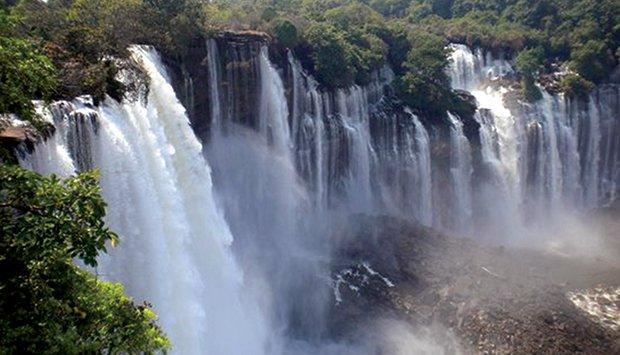Africa-Press – Angola. The municipality of Calandula marks, today, 93 years of existence. Founded on September 2, 1929, the municipality gains greater visibility, highlighting the famous Calandula Falls, the second largest in Africa, along with other tourist attractions, such as the Musseleje Falls, from Bango to Zenze, the Queen’s Table Njinga Mbande, among others. The musical instrument, the marimba, is another major attraction.
The municipal administrator, Mateus Vunge, considers that the municipality is still far from the desired level of development, but much has already been done.
“We are talking about investments in various sectors such as Education, where, for example, the construction and rehabilitation of 26 classrooms is underway. We are talking about 52 classes that will be available for the next academic year about to start. of 2 thousand students who will be able to benefit from these infrastructures”, he explained.
The municipality of Calandula will also have, in the academic year about to start, a Technical Institute of Health, which is practically completed, whose opening awaits authorization from the Ministry of Education.
“The institute will have 12 rooms, including a laboratory and a library. In a first phase, it will open the Nursing and Clinical Analysis course. In terms of capacity, we are talking about more than 500 students for the Technical Institute of Health”, said.
The Technical Institute of Health will receive young people from the municipality of Massango and the city of Malanje.
In the field of Health, the Municipality’s Multipurpose Medical Center was built, which will relieve the Municipal Hospital.
Tourist potential
The municipality of Calandula has a remarkable tourist and agricultural potential .
In this regard, it is worth noting the existence of one of the largest farms in the country, UNICANDA, which has contributed immensely to raising the social level of local populations.
“We have some investments in the tourism sector and the restaurant sector is also starting to come to life”, said the administrator, underlining the fact that it still does not meet demand. “We started looking at the Calandula Falls, which so far lacks investment, and we plan to carry out activities to encourage national and foreign investors”, he said.
For the development of Calandula, the authorities have in mind the creation of a Pole, which foresees the emergence of several infrastructures in a very vast area.
There is the prospect of the emergence of resorts, hotels, restaurants, to guarantee the accommodation of visitors.
“We still don’t have the economic growth that we would like to have. Everything depends on private investment, therefore, the capacity of private investment is what will dictate the growth of the municipality. The State is opening up the possibility of private investment so that, by itself, the market to regulate itself, but even so, we will continue to carry out actions in order to continue to mobilize entities to invest and be able to benefit the community from an economic point of view and generate employment for young people here in the municipality”, said Mateus Vunge, when referring to the Calandula Falls.
Residents of the town are waiting for better days.
Virgílio Ambrósio has lived in that municipality for six years and earns a living with a beauty salon, which he installed right in the center of the village.
The establishment of energy, in the municipality, catapulted the business. Daily, two to six people seek the services.
José Viriato set up his business on the main avenue of the village of Calandula where he sells various telephone sets, ZAP kits, among others.
” There are a lot of people looking for my service, especially ZAP decoders. The business is profitable, I’ve been doing it for 3 years.
Francisco Hebo has lived in Calandula for over seven years.
“Actually, what we want here is to diversify the training options. We also want higher education to be implemented here in the municipality, because many of us just don’t grow more academically due to lack of training opportunities”, he said.
After pointing out that the supply of electricity from the Laúca hydroelectric dam was one of the municipality’s greatest gains, our interlocutor asked the local administrative authorities to solve the problem of supplying drinking water that worries the population.
Bernardo Dala, who has lived in Calandula for three years, is satisfied with the cleanliness of the village.
“There are already notable changes. The way the village looks clean is a sign that something is changing. Energy is already an asset. There is some delay in the water, this case needs to be seen. happen,” said Bernardo Dala.
João Manuel Salvador was born and has lived in Calandula for over 30 years. He is a teacher. For our interlocutor, it is urgent that the water supply situation be resolved. “There is a huge water deficit. He said that the fountains set up by the local administration have not met the needs of the population.
Madalena Jamba has been a nursing technician for three years in the municipality. She is satisfied with the work she does and commends the efforts of the administrative authorities for the work that has been carried out.
It asks for the support of the entire community so that it can make its contribution to the improvement of the municipality.
With 70 thousand and 73 square kilometers and with an estimated population of more than 100 thousand inhabitants, Calandula has the main communes, Cateco Cangola, Cuale and Quinje.
Until 1975, the year in which independence was proclaimed, Calandula was known as Duke of Bragança, a name given in honor of the Portuguese sovereign Dom Pedro V.
For More News And Analysis About Angola Follow Africa-Press






